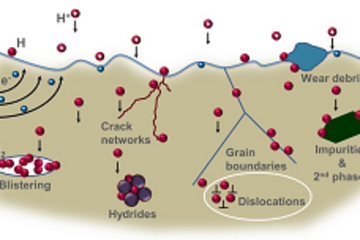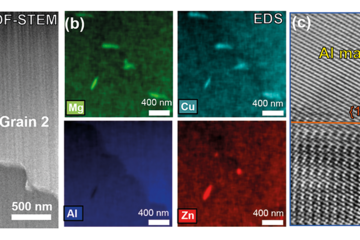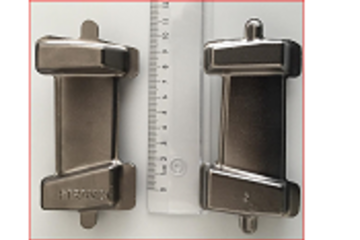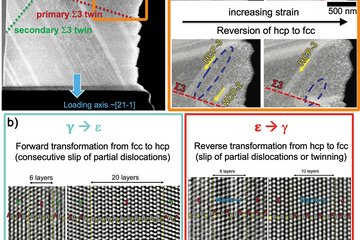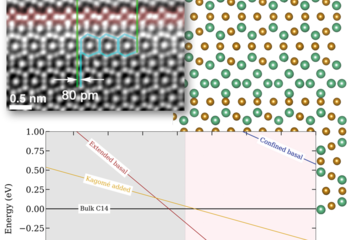All genres
21.
Journal Article
Localized deformation inside the Lüders front of a medium manganese steel. Materials Science and Engineering A: Structural Materials Properties Microstructure and Processing 824, 141816 (2021)
22.
Journal Article
Precipitation formation on ∑5 and ∑7 grain boundaries in 316L stainless steel and their roles on intergranular corrosion. Acta Materialia 210, 116822 (2021)
23.
Journal Article
Influence of sample preparation on nanoindentation results of twinning-induced plasticity steel. International Journal of Minerals, Metallurgy and Materials 28, pp. 877 - 887 (2021)
24.
Journal Article
Interacting with current. Nature Materials 20 (4), pp. 448 - 449 (2021)
25.
Journal Article
Reducing hot tearing by grain boundary segregation engineering in additive manufacturing: example of an AlxCoCrFeNi high-entropy alloy. Acta Materialia 204, 116505 (2021)
26.
Journal Article
Hydrogen effect on the mechanical behaviour and microstructural features of a Fe–Mn–C twinning induced plasticity steel. International Journal of Minerals, Metallurgy and Materials 28, pp. 835 - 846 (2021)
27.
Journal Article
The brittle-to-ductile transition in cold-rolled tungsten sheets: Contributions of grain and subgrain boundaries to the enhanced ductility after pre-deformation. Nuclear Materials and Energy 25, 100769 (2020)
28.
Journal Article
Microscale plastic anisotropy of basal and pyramidal I slip in pure magnesium tested in shear. Materialia 14, 100932 (2020)
29.
Journal Article
The combined and interactive effects of orientation, strain amplitude, cycle number, stacking fault energy and hydrogen doping on microstructure evolution of polycrystalline high-manganese steels under low-cycle fatigue. International Journal of Plasticity 134, 102803 (2020)
30.
Journal Article
New techniques for imaging and identifying defects in electron microscopy. MRS Bulletin 44, pp. 450 - 458 (2020)
31.
Journal Article
Current Challenges and Opportunities in Microstructure-Related Properties of Advanced High-Strength Steels. Metallurgical and Materials Transactions A 51, pp. 5517 - 5586 (2020)
32.
Journal Article
Direct observations of collinear dislocation interaction in a Fe–17.4 Mn–1.50 Al–0.29 C (wt.%) austenitic steel under cyclic loading by in-situ electron channelling contrast imaging and cross-correlation electron backscatter diffraction. Scripta Materialia 186, pp. 341 - 345 (2020)
33.
Journal Article
The effect of solid solution and gamma prime on the deformation modes in Ni-based superalloys. Acta Materialia 194, pp. 257 - 275 (2020)
34.
Journal Article
Unravelling the effect of hydrogenon microstructure evolution under low-cycle fatigue in a high-manganese austenitic TWIP steel. International Journal of Plasticity 126, 102625 (2020)
35.
Journal Article
On the assessment of creep damage evolution in nickel-based superalloys through correlative HR-EBSD and cECCI studies. Acta Materialia 185, pp. 13 - 27 (2020)
36.
Journal Article
Quantitative multiscale correlative microstructure analysis of additive manufacturing of stainless steel 316L processed by selective laser melting. Materials Characterization 160, 110074 (2020)
37.
Journal Article
On the resolution of EBSD across atomic density and accelerating voltage with a particular focus on the light metal magnesium. Ultramicroscopy 207, 112828 (2019)
38.
Journal Article
Anomalous twinning in AZ 31 magnesium alloy during electrically assisted forming. Materials Letters 255, 126516 (2019)
39.
Journal Article
Visualization and Observation of Morphological Peculiarities of Twin Formation in Mg-Based Samples After Electrically Assisted Forming. Metallography, Microstructure, and Analysis 8 (6), pp. 806 - 814 (2019)
40.
Journal Article
Density, distribution and nature of planar faults in silver antimony telluride for thermoelectric applications. Acta Materialia 178, pp. 135 - 145 (2019)




